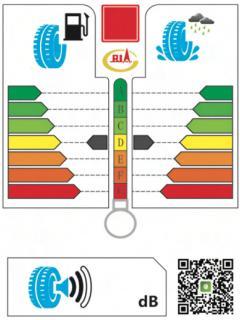

A tire label refers to a mark for consumers to decide what to purchase. It reflects the performance indexes in all aspects of a product. Because the label style shows the tire performance indexes vividly and visually, it is a feasible way of declaration.
The tire label is an information label attached on a tire product used for showing the rolling resistance coefficient grade, wet grip performance grade and noise grade of a tire product to provide necessary information for consumers to make a decision on whether to buy a tire as well as guide and help them to choose the cost-effective product.
On the tire label, there are three performance indexes of the tire, including tire rolling resistance coefficient (energy efficiency), wet grip performance grade (safety) and noise grade.
1. Rolling Resistance Coefficient (Energy Efficiency Grade)
In the fuel consumption of the automobile, over 20% is contributed by tire. The energy efficiency is graded by RRC (Rolling Resistance Coefficient). There are 6 grades from A to G, in which Grade D of saloon car tires is blank and Grade G of truck tires is also blank. Grade A means the best economic performance of fuel, and Grade G means the worst. The fuel consumption difference between Grade A and Grade G is 7% ~ 8%.
Green label refers to Grade A, and red label refers to Grade G.
Taking saloon car tires as an example, Grade A RRC ≤ 6.5, which is shown green on the label and means the most fuel-efficient; Grade G RRC ≥ 12.1, which is shown red on the label and means the least fuel-efficient.
Suppose the average fuel consumption of a saloon car is 9L/100km (SUV and saloon car) and the life is 50,000km, every car saves 68L gasoline (four tires) and every tire saves 17L gasoline when it is one grade forward.
Truck tires: Grade A RRC ≤ 4.0, which is shown green on the label and means the most fuel-efficient;
Grade F RRC ≥ 8.1, which is shown red on the label and means the least fuel-efficient.
2. Wet Grip Performance Grade
The wet grip performance of tires is graded by the wet grip index (G). The distance from braking to being static at a speed of 80km/h is chosen as the reference standard, and the braking distance of tires in Grade A of grip performance is 18m shorter than that of the worst in Grade G. Grade A means the best, which is green on the label; and Grade G means the worst, which is red on the label.
The wet grip performance of saloon car and light truck tires is divided into 5 grades from A to G, in which Grade D and Grade G are blank. In Grade A, the wet grip performance index 1.55 ≤ G, and in Grade F, the wet grip performance index F ≤ 1.09.
The wet grip performance of truck tires in divided into 6 grades from A to G, in which Grade G is blank. In Grade A, the wet grip performance index 1.25 ≤ G, and in Grade F, the wet grip performance index F ≤ 0.64.
When it is one grade forward, people can have a longer distance of 3~5m for yourself and others in a vital emergency brake during a rainy day. Such a decision not only concerns the payment of money but also concerns the cost of life.
The following figure shows the influence of the wet braking performance of saloon car tires on the braking distance from 80km/h→0.

3. Tire Noise Grade
The noise grade N of tires is divided by the limiting value of the noise, which includes 3 grades from A to C. The noise value of tires is also shown on the label. Tires with different section widths have different limiting values of noise, and the limiting value is the minimum threshold. Grade A means the best, and Grade C means the worst. Taking the nominal section width of saloon car tires≤185mm as an example, the noise value of Grade A is 67dB, and that of Grade C is higher than 70dB.
4. Example of Tire Label
